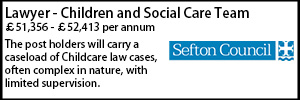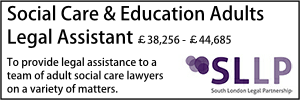Public law children case update: August 2022
- Details
Jaime Turner rounds up the most interesting and relevant public law cases.
Re G (Child Post-Mortem Report: Delays) [2022] EWFC 55 14 June 2022
Overview
Sir Andrew McFarlane, President of the Family Division gives an unusual judgment following a vacated case management hearing in pending public law child care proceedings under Children Act 1989, s 31 [CA 1989]. The proceedings relate to the sibling of a 4-month-old baby who died in suspicious circumstances in October 2021 following a profound collapse at the family home four days earlier. The purpose of his judgment is “to bring a spotlight to bear upon the wholly unsatisfactory delays that are now regularly being encountered in obtaining post-mortem reports in suspected child homicide cases, and to describe possible alternative ways for the Family Court to proceed”.
The Problem
Whilst the post-mortem examination, which is conducted by a lead forensic pathologist, will normally be undertaken promptly and within days of the death, material collected during the post-mortem is then likely to be sent off for specialist analysis by other experts and it is this latter process which can generate extensive delay. The preparation of the overall post-mortem report can only move to a conclusion at the pace of the slowest contributor, and it cannot be completed by the lead pathologist until the reports of each of the specialists has been received. In the present case the Family Court was told in February 2022 that it would be a further 9 to 12 months before the post-mortem report would be completed [para 3].
The President highlights that delay of this magnitude plainly has a profound impact on both the pending criminal process and upon any related child protection proceedings in the Family Court [para 4]. It is only after the report becomes available that the police can conduct formal interviews based upon it with the parents and other family members. In order to maintain confidentiality with respect to some of the evidence that the police have obtained from other sources, that other evidence will only be made available to the parents during those interviews and to the Family Court proceedings thereafter [para 5].
The potential delay encountered in the present case is not unusual, it is now the norm for there to be delay of the order of one year in the preparation of a post-mortem report following the suspicious death of a child. The President states that, for surviving siblings to have to wait in limbo in foster care or elsewhere for a period of two or more years before the plans for their future care can be determined is wholly unacceptable. The Family Court is required to 'have regard to the general principle that any delay in determining [any question with regard to the upbringing of a child] is likely to prejudice the welfare of the child' [Children Act 1989, s 1(2)] and must work to a timetable to determine an application for a care order within 26 weeks from its issue [CA 1989, s 32(1)(a)]. The timescales that are now regularly encountered in care proceedings following the death of a child are wholly outside those required by Parliament and they are plainly contrary to the welfare of any surviving sibling who is the subject of such proceedings [para 6].
In the present case, the Home Secretary submitted an 'Explanatory Note' describing the background circumstances [para 10]: ‘4. The dearth of sub-speciality pathologists willing to engage in the criminal justice system impacts child and baby death cases. These cases are also particularly complex due to the need to exclude natural disease and conditions associated with age. This has meant that the few sub-speciality pathologists who are willing to take on such cases are overburdened with case work. It is not unusual for a report from a sub-speciality pathologist to take up to six months before it is ready to send to the forensic pathologist (and nine months for bone examination). If this position persists, it is likely that the ability of the police and coroners to thoroughly investigate complex deaths will be severely hampered, and court dates will continue to be missed. 5. It is worth noting again that the system of medical death investigation in England and Wales is a private service, not provided by the state, but reliant on coroners and the police paying for services of self-employed professionals.’
The President acknowledges that, whilst some ameliorating action may be in hand to increase the number of experts in the specific field of osteoarticular pathology, this may only trim back the extent of delay, rather than eradicate it. He identifies that the system is similarly vulnerable, albeit to a lesser degree, by shortages of experts in other fields. The President concludes that “It is no business of the court to engage in policy matters, but it is to be noted that the option of establishing a national service is not currently being taken forward by government” [para 14].
The President goes on to consider what solutions are open to the Family Court:
(a) Instruction of an alternative post-mortem expert: it is acknowledged that the instruction of a second expert is, however, unlikely to provide a viable solution in most cases [para 18]. The President notes that it is apparently the case that there is currently no agreed protocol between the Police and the Family Court concerning the safe and secure physical transfer of samples for analysis by experts instructed in Family proceedings. On the publication of this judgment, the President invites the newly re-constituted Family and Criminal Interface Committee to consider this, and the wider issues raised [Para 19].
(b) Use of evidence gathered prior to death: it was submitted that one option open to the Family Court where, as here, there is evidence which is gathered while the child was still alive and which is capable of supporting a finding of child abuse, is for the case to proceed on the basis of that material without the need for the court to go further and consider post-mortem evidence [para 21]. Counsel submitted that, just as would be the case where a child, who has apparently been injured in this way, has not died, evidence of significant pre-death injury attributable to abuse is likely to be sufficient for the purposes of the Family Court in proceedings under s 31 in determining the threshold criteria and evaluating which of any competing care options best meets the welfare needs of any surviving child(ren) [para 22].
Counsel for the father summarised the situation as follows: 'Accordingly, in cases such as this, we submit that it is open to the Family Court to consider instruction of experts pursuant to Part 25 of the FPR at an early stage of proceedings, should such instruction be capable of providing the Court with the evidence necessary to determine threshold issues without having to await the full post-mortem report from the Home Office instructed pathologist. There is for example, the potential for a neurosurgeon, ophthalmologist and neuro-radiologist to be instructed, with those experts providing an opinion in relation to causation based upon the available imaging and medical records. Such expert evidence could allow the Court to consider the issue of causation and whether it is directly attributable to the actions of a parent, without needing to await the reports of any experts instructed by the police for the purposes of the completion of any final post-mortem report…’
The President refers to the recent consideration given to the circumstances in which it is, or is not, necessary for the Family Court to engage in fact-finding with respect to serious allegations made within CA 1989, s 31 proceedings. In Re H-D-H and C (Children: Fact-Finding) [2021] EWCA Civ 1192; [2022] 1 FLR 454 the Court of Appeal endorsed the approach that had been described in a judgment that the President had given at first instance in Oxfordshire County Council v DP, RS, BS (By the Children's Guardian) [2005] EWHC 1593 (Fam), subject to some additional considerations in order to meet the overriding objective.
The President notes an example of how the approach endorsed by the Court of Appeal in Re H-D-H may be applied in a case of suspected child homicide is provided by the decision of Lieven J in Lincolnshire CC v CB [2021] EWHC 2813; [2022] 1 FCR 99 in which a delayed listing for a four-week fact-finding hearing was refused in favour of an earlier five-day consolidated hearing with more limited findings of fact. Lieven J identified the 'true question' for the court as being 'whether the fact-finding is truly "necessary" for the ultimate welfare decision that the court has to make' [para 28].
The President recommends that, whilst neither H-D-H nor Lincolnshire CC v CB dealt with the situation facing the court as a result of delays in the provision of post-mortem reports, evaluation of the case management options available to the court in such cases through the lens described in Oxfordshire CC v DP and H-D-H is likely to be appropriate. He advises that “In cases where the death of a child is sudden, with little or no evidence of pre-death injury or symptoms, for example where the cause of death is suspected to be suffocation, there may be no alternative but to await receipt of the full post-mortem report. But in other cases, where there is apparently a range of evidence prior to death which, if established, would be sufficient for the court to determine both the s 31 threshold and the ultimate welfare decision, it may not be 'necessary' to await the full post-mortem report where the impact on the child's welfare in postponing the process until that report is received may be disproportionate and unacceptable” [para 29].
Conclusion
The President stresses that this judgment is not intended to lay down how any particular future cases should be determined, as it will be a matter for the judges in those cases to evaluate the options available on the facts of each case, but expresses his wish to “be plain that it is no longer acceptable for the Family Court simply, and passively, to accept that a post-mortem report will take a year and that the Family proceedings must therefore be put on hold. The need to meet the welfare needs of the surviving child(ren) and the statutory duty to conclude the proceedings within 26 weeks impose a requirement on the Family Court to be proactive in considering options by which such evidence as is 'necessary' to establish the s 31 threshold and determine the ultimate welfare question can be obtained from other sources” [para 31].
The President concludes that it is a matter for the Police, HM Coroners and others what steps may be taken to alleviate the current extreme reported delays in obtaining post-mortem reports for use in the criminal justice and coronial systems. The President is clear that the Family Justice system should no longer passively put up with the consequences of a wholly unacceptable regime. In future the Family Court should only be obliged to delay its proceedings to await receipt of a post-mortem report in a suspected child homicide where it is truly 'necessary' to do so in order to achieve the overriding objective of dealing with cases justly, having regard to the welfare issues involved. In all other cases, the court should consider adopting alternative strategies to achieve a more expeditious resolution of the proceedings, whilst still meeting the overriding principles [para 32].
D (A Child: Placement Order), Re [2022] EWCA Civ 896 (30 June 2022) (In the Court of Appeal (Civil Division) on appeal from the Family Court at Liverpool: His Honour Judge Greensmith) (30 June 2022)
Lady Justice King, Lord Justice Peter Jackson and Lord Justice Popplewell allow an appeal and remit the matter for a rehearing. The question on this appeal is whether a decision that a child could not be placed with his grandmother but should instead be placed for adoption was reached after such a rigorous evaluation and comparison, or whether, as the grandmother argues, the process was deficient because the court did not fully evaluate the option of a placement with her, nor properly compare its advantages and disadvantages with the advantages and disadvantages of adoption.
Lord Justice Peter Jackson highlighted the recent decision of the Supreme Court in H-W (Children) [2022] UKSC 17 which underlines that a decision leading to adoption, or to an order with similarly profound effects, requires the rigorous evaluation and comparison of all the realistic possibilities for a child's future in the light of the court's factual findings. Adoption can only be approved where it is in the child's lifelong best interests and where the severe interference with the right to respect for family life is necessary and proportionate. The court must therefore evaluate the family placement and assess the nature and likelihood of the harm that the child would be likely to suffer in it, the consequences of the harm arising, and the possibilities for reducing the risk of harm or for mitigating its effects. It must then compare the advantages and disadvantages for the child of that placement with the advantages and disadvantages of adoption and of any other realistic placement outcomes short of adoption [para 1].
Background
The appellant, aged 51, is the maternal grandmother of B, a boy aged 3. She has two daughters. The elder, who lives some 50 miles away, has three children, two girls and B. She and the children's father are both deaf. In 2019, care orders were made in respect of the two girls, and they were placed with their paternal grandparents. As for B, he was removed at birth and has been in foster care all his life [para 4].
In early 2020, following the removal of the sisters, the parents were convicted of child cruelty, arising from their grossly inadequate home conditions. Other concerns that led to the care proceedings relating to the sisters and to B's proceedings centred on domestic abuse in the parents' relationship and their dishonesty with professionals [para 5].
A final order was made in respect of B on 24 January 2022 after a hearing that had lasted for a total of 21 days in four episodes. Difficulties were experienced with intermediaries, signing interpreters, illnesses and computer technology, and adjournments were granted for further assessments to take place [para 6].
The grandmother had put herself forward to look after B from the outset. She was negatively assessed as a foster carer by the local authority in March 2020 because of concerns about her health, her home conditions, her smoking, and the history of her own parenting. However, in June 2020 an order was made for an assessment by an independent social worker ('ISW1') and in August 2020 she was joined as a party, obtaining legal representation in January 2021 [para 7].
The report of ISW1 in August 2020 identified some strengths in the grandmother's ability to meet B's needs, but it too did not recommend her as a foster carer or a special guardian. The assessor was particularly concerned about the closeness of the relationship between the grandmother and B's mother [para 8]. When the first episode of the final hearing took place, the judge was highly critical of the evidence of ISW1, apparently because of concerns about the witness's understanding of special guardianship. In a recording to an order of 4 December 2020, the assessment was described as "woefully inadequate and of limited value to the court". Another assessment was commissioned as a result. This was carried out by ISW2, who reported in March 2021 and made a recommendation that was generally favourable to the grandmother [para 9]. The local authority did not accept the opinion of ISW2, and it declined to approve the grandmother as a foster carer [para 10].
The judge delivered a written judgment totalling nine pages. He concluded that the parents were incapable of providing good enough parenting for B. The judge made findings as set out in [para 13] of his judgment. He concluded as follows: "51. … My conclusion that B cannot be placed with his parents is based upon my finding that satisfactory home conditions are unlikely to be maintained and that the toxicity of the relationship between the parents will be a constant threat to B's emotional and physical safety. I am satisfied that the maternal grandmother is incapable of protecting B from that dangerous relationship”.
Lord Justice Peter Jackson gave the following reasons for allowing the appeal:
- “On analysis, there are three strands to the grandmother's arguments, which have evolved since I gave permission to appeal.
- The first is that some of the findings listed above were not justified by the evidence.
- The second is that no balanced evaluation of the grandmother's position was made.
- The third is that the welfare implications for B of living with his grandmother were not compared with those of adoption.
On behalf of the local authority, it is accepted that the short judgment did not address a number of relevant matters, but it is argued that the kernel of the decision is soundly based on matters contained in the judgment and the evidence and that any omissions are inessential” [para 15].
- “On the basis of the professional assessments, there were undoubtedly a number of justified reasons for concern about the grandmother as a carer for B…However, there is real force in the argument that there were other matters that were not taken into account in evaluating the option of a placement with the grandmother” [para 16 & 17].
- “Another issue arises from the treatment of the calls to the police, later untruthfully denied. This was a classic double-edged sword, but no regard was had to the protective aspect of the grandmother's actions or the confirmation they give that she does not approve of the father. Nor was reference made to the fact that she had brought up and advocated for her own children, one deaf and the other with dyslexia, or to the strong commitment she had shown in putting herself forward to care for B. Finally, the judge made no reference at all to the more recent opinion of ISW2, preferring the opinion of ISW1, despite his earlier strictures. These matters clearly needed to be addressed and, if they were not to carry some weight, explained” [para 18].
- “More centrally, to borrow from H-W at [51], the judge telescoped the process. At paragraph 40, he stated that the grandmother could not be a special guardian if she was shown to be unwilling or unable to protect B from the parents' toxic relationship. He then ruled her out because he found that she would be incapable of protecting him from the risk of significant emotional harm and maybe physical harm if he were to become caught up in one of their arguments. He effectively treated this one undeniably important matter as if it was the ultimate question, and as if any risk of parental involvement, however limited, was to be regarded as fatal” [para 19].
- “…the court had to assess the nature and likelihood of the harm that B would face in the grandmother's care, the consequences for him if it arose, and the possible ways of reducing the risk or mitigating its effects. This required an evaluation of whether the parents, and in particular the father, could be kept at arm's length. A number of questions had to be squarely asked.
- How likely was it that they would try to interfere?
- What might she do if they did?
- What would the consequence be of unauthorised contact, however limited?
- In short, what was the actual risk, and could it be managed with local authority supervision and support, or by orders preventing the parents coming to B's home area except in accordance with approved arrangements?
- If the risk could be managed, what benefits might come to B from knowing his parents, or at least his mother, and his siblings, aunt and cousin during his childhood?
- These questions were not addressed, and the evaluation of the internal strengths and weaknesses of the grandmother's position was therefore incomplete” [para 20].
- “Finally, because the judge had ruled out the option of placement with the grandmother, he did not compare it meaningfully with the alternative plan for adoption. He referred only in passing to the statutory checklists and he did not mention the principle of proportionality” [para 21].
Jaime Turner is a pupil barrister at St Mary's Family Law Chambers.





















































